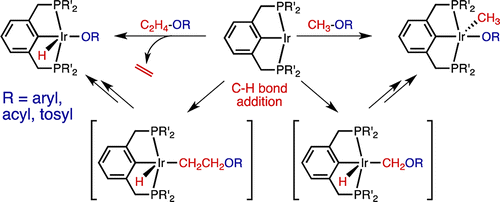当前位置:
X-MOL 学术
›
J. Am. Chem. Soc.
›
论文详情
Our official English website, www.x-mol.net, welcomes your
feedback! (Note: you will need to create a separate account there.)
Cleavage of Ether, Ester, and Tosylate C(sp3)–O Bonds by an Iridium Complex, Initiated by Oxidative Addition of C–H Bonds. Experimental and Computational Studies
Journal of the American Chemical Society ( IF 14.4 ) Pub Date : 2013-03-21 , DOI: 10.1021/ja312464b Sabuj Kundu 1 , Jongwook Choi 1 , David Y. Wang 1 , Yuriy Choliy 1 , Thomas J. Emge 1 , Karsten Krogh-Jespersen 1 , Alan S. Goldman 1
Journal of the American Chemical Society ( IF 14.4 ) Pub Date : 2013-03-21 , DOI: 10.1021/ja312464b Sabuj Kundu 1 , Jongwook Choi 1 , David Y. Wang 1 , Yuriy Choliy 1 , Thomas J. Emge 1 , Karsten Krogh-Jespersen 1 , Alan S. Goldman 1
Affiliation

|
A pincer-ligated iridium complex, (PCP)Ir (PCP = κ(3)-C6H3-2,6-[CH2P(t-Bu)2]2), is found to undergo oxidative addition of C(sp(3))-O bonds of methyl esters (CH3-O2CR'), methyl tosylate (CH3-OTs), and certain electron-poor methyl aryl ethers (CH3-OAr). DFT calculations and mechanistic studies indicate that the reactions proceed via oxidative addition of C-H bonds followed by oxygenate migration, rather than by direct C-O addition. Thus, methyl aryl ethers react via addition of the methoxy C-H bond, followed by α-aryloxide migration to give cis-(PCP)Ir(H)(CH2)(OAr), followed by iridium-to-methylidene hydride migration to give (PCP)Ir(CH3)(OAr). Methyl acetate undergoes C-H bond addition at the carbomethoxy group to give (PCP)Ir(H)[κ(2)-CH2OC(O)Me] which then affords (PCP-CH2)Ir(H)(κ(2)-O2CMe) (6-Me) in which the methoxy C-O bond has been cleaved, and the methylene derived from the methoxy group has migrated into the PCP Cipso-Ir bond. Thermolysis of 6-Me ultimately gives (PCP)Ir(CH3)(κ(2)-O2CR), the net product of methoxy group C-O oxidative addition. Reaction of (PCP)Ir with species of the type ROAr, RO2CMe or ROTs, where R possesses β-C-H bonds (e.g., R = ethyl or isopropyl), results in formation of (PCP)Ir(H)(OAr), (PCP)Ir(H)(O2CMe), or (PCP)Ir(H)(OTs), respectively, along with the corresponding olefin or (PCP)Ir(olefin) complex. Like the C-O bond oxidative additions, these reactions also proceed via initial activation of a C-H bond; in this case, C-H addition at the β-position is followed by β-migration of the aryloxide, carboxylate, or tosylate group. Calculations indicate that the β-migration of the carboxylate group proceeds via an unusual six-membered cyclic transition state in which the alkoxy C-O bond is cleaved with no direct participation by the iridium center.
中文翻译:

铱络合物对醚、酯和甲苯磺酸酯 C(sp3)-O 键的裂解,由 C-H 键的氧化加成引发。实验和计算研究
发现钳形连接的铱络合物 (PCP)Ir (PCP = κ(3)-C6H3-2,6-[CH2P(t-Bu)2]2) 发生 C(sp(3) )-O 键的甲酯 (CH3-O2CR')、甲苯磺酸甲酯 (CH3-OTs) 和某些缺电子的甲基芳基醚 (CH3-OAr)。DFT 计算和机理研究表明,反应是通过 CH 键的氧化加成和氧化物迁移进行的,而不是通过直接添加 CO 进行。因此,甲基芳基醚通过添加甲氧基 CH 键进行反应,然后 α-芳基氧化物迁移得到顺式-(PCP)Ir(H)(CH2)(OAr),然后铱到亚甲基氢化物迁移得到( PCP)Ir(CH3)(OAr)。乙酸甲酯在甲氧基上发生 CH 键加成得到 (PCP)Ir(H)[κ(2)-CH2OC(O)Me],然后得到 (PCP-CH2)Ir(H)(κ(2)-O2CMe ) (6-Me) 其中甲氧基 CO 键已被裂解,来自甲氧基的亚甲基已迁移到 PCP Cipso-Ir 键中。6-Me 的热解最终得到 (PCP)Ir(CH3)(κ(2)-O2CR),这是甲氧基 CO 氧化加成的净产物。(PCP)Ir 与 ROAr、RO2CMe 或 ROTs 类型的物质反应,其中 R 具有 β-CH 键(例如,R = 乙基或异丙基),导致形成 (PCP)Ir(H)(OAr),( PCP)Ir(H)(O2CMe) 或 (PCP)Ir(H)(OTs),以及相应的烯烃或 (PCP)Ir(烯烃) 络合物。与 CO 键氧化加成一样,这些反应也通过 CH 键的初始活化进行;在这种情况下,在 β 位添加 CH 之后是芳基氧化物、羧酸酯或甲苯磺酸酯基团的 β-迁移。
更新日期:2013-03-21
中文翻译:

铱络合物对醚、酯和甲苯磺酸酯 C(sp3)-O 键的裂解,由 C-H 键的氧化加成引发。实验和计算研究
发现钳形连接的铱络合物 (PCP)Ir (PCP = κ(3)-C6H3-2,6-[CH2P(t-Bu)2]2) 发生 C(sp(3) )-O 键的甲酯 (CH3-O2CR')、甲苯磺酸甲酯 (CH3-OTs) 和某些缺电子的甲基芳基醚 (CH3-OAr)。DFT 计算和机理研究表明,反应是通过 CH 键的氧化加成和氧化物迁移进行的,而不是通过直接添加 CO 进行。因此,甲基芳基醚通过添加甲氧基 CH 键进行反应,然后 α-芳基氧化物迁移得到顺式-(PCP)Ir(H)(CH2)(OAr),然后铱到亚甲基氢化物迁移得到( PCP)Ir(CH3)(OAr)。乙酸甲酯在甲氧基上发生 CH 键加成得到 (PCP)Ir(H)[κ(2)-CH2OC(O)Me],然后得到 (PCP-CH2)Ir(H)(κ(2)-O2CMe ) (6-Me) 其中甲氧基 CO 键已被裂解,来自甲氧基的亚甲基已迁移到 PCP Cipso-Ir 键中。6-Me 的热解最终得到 (PCP)Ir(CH3)(κ(2)-O2CR),这是甲氧基 CO 氧化加成的净产物。(PCP)Ir 与 ROAr、RO2CMe 或 ROTs 类型的物质反应,其中 R 具有 β-CH 键(例如,R = 乙基或异丙基),导致形成 (PCP)Ir(H)(OAr),( PCP)Ir(H)(O2CMe) 或 (PCP)Ir(H)(OTs),以及相应的烯烃或 (PCP)Ir(烯烃) 络合物。与 CO 键氧化加成一样,这些反应也通过 CH 键的初始活化进行;在这种情况下,在 β 位添加 CH 之后是芳基氧化物、羧酸酯或甲苯磺酸酯基团的 β-迁移。































 京公网安备 11010802027423号
京公网安备 11010802027423号